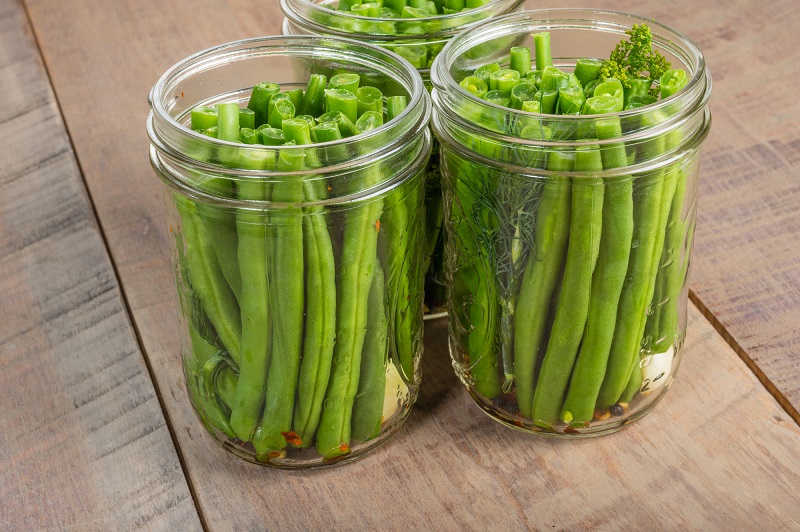You can ferment almost any product: vegetables, fruits, milk, meat, fish, and drinks. In recent years, we have been increasingly reminded of the benefits of using pickles as a delicious and natural way to enrich the microflora and strengthen the body’s immune system. Healthy and delicious recipes for fermenting vegetables.
Fermented vegetables are very useful for human health. But few people know that you can ferment almost any vegetable at home. The main thing is to know the technology and use suitable spices.
#1. Classic fermented beetroot recipe
It is quite simple to take care of the health of the intestinal microflora by including fermented foods suitable for you in the diet. Fermented beetroot, which not only nourishes the microflora but also has a warming effect. Crispy, spicy, slightly spicy, moderately salty!

Ingredients:
To get one container (1 liter), you will need 5 pieces of beets.
Cumin seeds 2 teaspoons
Coarse salt (kosher) 3 teaspoons
Cooled boiled water 2 cups
Greens (basil, parsley, dill) 1/2 cup.
Instruction:
Pour cumin seeds into the fermentation tank, and then put the thinly sliced beet slices.
Make a brine by dissolving the salt crystals in water. Pour in the beets.
Next, place the load to cover the entire perimeter of the sliced beetroot. Cover the top with a napkin.
Place the container on a tray or plate and leave at room temperature for 1 week.
You will notice that the fermentation process will begin to occur, and gas formation will occur. When the desired taste appears, you need to remove the load and put the closed container in a cold place. It can be stored for 3 months. You can mix cabbage and beets and also ferment.
#2.Fermented pumpkin
Sauerkraut goes well with vegetable stews, boiled potatoes, meat, and fish. It is very useful to serve this snack to the table, filling it with linseed oil – a valuable source of omega-3 fatty acids, which are often not enough in our diet.
Many supporters of a healthy diet know about the benefits of pumpkin: it is rich in carotenoids, and macro- and microelements, among which potassium, calcium, sodium, magnesium, iron, and phosphorus can be distinguished. Pumpkin also contains vitamins B1, B9, C, PP, and K, and even a rare vitamin T, which accelerates metabolic processes in the body.
However, during heat treatment, many biologically active substances are destroyed. And fermentation allows not only to preserve of vitamins and trace elements but also to obtain a valuable probiotic product that positively affects the intestinal microflora.

Ingredients:
Pumpkin 35.24oz
Peppercorns, cinnamon to taste
Dill or parsley to taste
Salt 2 teaspoons
Fresh garlic 3 pcs
Instruction:
Choose a sweet and whole pumpkin and cut it into pieces It is important that they are the same.
Make a brine: mix salt and spices in filtered water. Pour the pieces of fruit put in the bowl with garlic and herbs.
Cover the top with a cloth and tie it. Make sure that there is always brine, and top up the water if necessary. After 3-4 days, carbon dioxide bubbles will appear and an aroma will appear. Move the pumpkin to a cold place so that it does not sour.
#3. Fermented bell pepper stuffed with vegetables. Healthy and delicious recipes for fermenting vegetables.
Pepper fermentation takes place quite quickly, so in 3-4 days you will have a delicious spicy addition to the main dish or just an appetizer on the table.

Ingredients:
Bulgarian pepper 35.24oz
Cabbage 35.24oz
Carrots 1 piece (large)
Onion 1 piece (large)
Green tomatoes 7.0oz
Salt (not iodized) 2 tablespoons
Hot pepper 1 small pod (optional)
Parsley 1 bunch
Pepper peas, bay leaf to taste
Vegetable oil 4 tablespoons
Instruction:
Wash the pepper, and remove the seeds. Finely chop the cabbage. Peel the onion and carrot, cut the onion into small cubes, and grate the carrots on a coarse grater. Remove the seeds from the green tomatoes and cut them into small strips. Heat a frying pan with vegetable oil. Fry the onion on low heat for 2-3 minutes, then add the chopped tomatoes, stir fry for 10 minutes (until the liquid evaporates), add the grated carrots, and fry for another 10 minutes. Cool it down.
Grind the chopped cabbage with salt until the juice is released, add the fried vegetables, chopped parsley, finely chopped hot pepper, and peas, and mix well. Boil water in a saucepan and blanch the prepared bell pepper for 2 minutes. Remove the pepper from the boiling water and pour cold water over it. Each pepper is tightly stuffed with a cooked vegetable mixture.
At the bottom of the dishes in which the pepper will be fermented, we spread sprigs of parsley, dry dill, bay leaf, and black pepper peas. Then stuffed pepper. Strain the remaining juice from the minced meat and pour it over the peppers. On top of the bay leaf again, sprigs of parsley, cover with a lid or plate and put the load on top (one a-half liter jar of water). Leave at room temperature for 2-3 days for fermentation. Then put the pepper in a container or jar and put it in the refrigerator. Enjoy your appetite!
#4.Fermented garlic
Pickled garlic is not only very useful but also really delicious! From this recipe, you will learn how to quickly and simply ferment garlic at home.

Ingredients:
Number of servings: 10
Garlic 35.24oz
Salt 2 tablespoons
Water 4 cups
Hot pepper 1 piece
Horseradish leaves 3 pieces
Allspice peas 8pcs
Bay leaf 6 pcs
Dill, currant leaves, and cherry leaves to taste
Instructions:
Pickled garlic makes sense to make from young and strong garlic heads, which have already formed dense large cloves, but the husk has not yet become rigid. What I like most of all is that you can pickle garlic with whole heads, or by disassembling it into teeth: and it turns out perfectly! Fragrant crispy sauerkraut garlic does not leave our table all winter — try it too!
#5.Fermented green beans. Healthy and delicious recipes for fermenting vegetables.
This wonderful snack is perfectly obtained without vinegar. Due to the preservation of its own enzymes and vitamins, it can be stored for at least a month.

Ingredients:
Water 35.24oz
Sea salt 2 tablespoons
Young string beans 28.22oz
1 teaspoon of hot pepper
Garlic, peeled and crushed 3 cloves
Dill greens 3.53oz
Instructions:
Prepare the brine by dissolving the salt in water. Prepare the container.
Put pepper, garlic, and dill in both jars.
Place the asparagus beans on top – vertically, if it is thin and long, or across the one that is thicker and sliced. Pour the brine without bringing it to the top of the jar.
Close the lid or cover with a cloth on top. Leave to ferment until the desired taste is achieved (at room temperature). If you close the lid, then open it periodically to relieve the pressure inside.
After 3-4 days at the end of fermentation, close the jars with lids and put them in a cold place. Enjoy your appetite!



